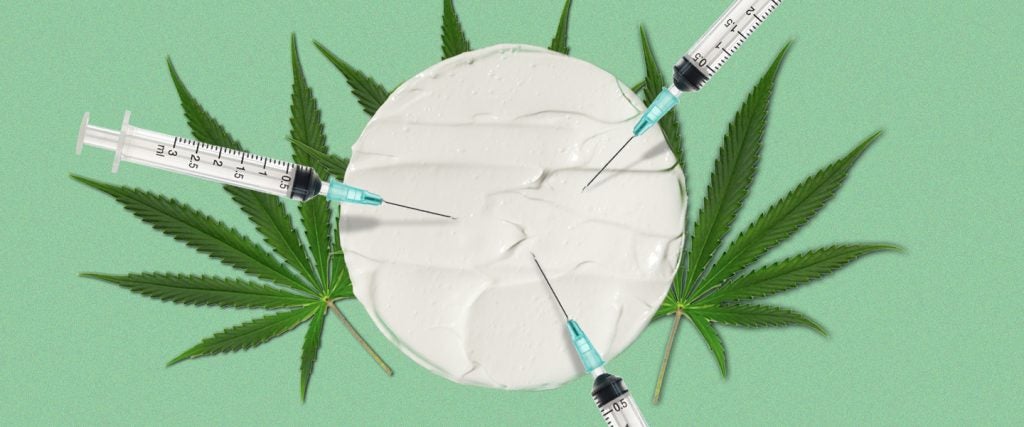Naturally, in our peak CBD world, CBD oil is all the rage, and CBD creams are lauded for possessing pain-relief capabilities that border on magic.
But that’s really only due to hype that doesn’t extend beyond a cursory glance. Upon a closer look, it’s hard to miss that most creams advertised as CBD-based contain a consistent collection of three or four other ingredients. So it would seem that before we go treating CBD cream as God’s gift to those in need of relief from all aches experienced from the neck down, it’s worth investigating some of the frequent mixing companions of CBD contained therein, along with the benefits associated with their use.
What do you mean? What are companies sticking in CBD cream?
First on the list is MSM, which is far easier to write and pronounce than “methylsulfonylmethane,” which is its actual name. MSM is frequently taken as an oral supplement to combat arthritis, but when topically applied, MSM is scientifically-backed as a reducer of joint pain, stiffness and swelling. So, yes, CBD is already packed with at least one other chemical property intended to alleviate physical pain.
Next up is arnica, which is extracted from a flower of the same name, and often placed into gels and creams for the purpose of providing pain relief, inflammation reduction and bruise prevention. There are studies that bolster the claim that arnica is effective when assigned to address all of these problems. On the other hand, there’s an additional study that arnica can have a deleterious influence in amplifying lower-body pain. Certainly, studies on arnica’s benefits (or lack thereof) are still being conducted, but the obvious intent in its inclusion in creams is as an anti-inflammatory and pain-reducing agent.
The spice turmeric is also included in several of these mixtures, and turmeric has numerous health-improving properties associated with the curcumin contained within it. If you’ve already reached this point, it should come as no surprise that the topical application of curcumin is linked to the loss of inflammation, the reduction of pain and the abating of arthritis symptoms.
The freshly squeezed oil of emus has been used for centuries by aboriginal Australians to relieve minor aches and pains. At least one study has positively linked emu oil with effectiveness of wound healing in burn victims. Conversely, while emu oil is sold as a pain reliever, there are no conclusive studies that prove its pain-relief properties. By the same token, that hasn’t stopped companies from selling pain-reduction creams where the emu oil is the supposed star, even if the active ingredient within said creams is trolamine salicylate, aka “aspercreme.”
It sounds like these are all filled with products that either relieve pain, or claim to relieve pain.
They’re certainly using the shotgun approach, aren’t they? You’d think if CBD could stand alone as a pain reliever, it could do so with minimal help from other sources. However, it’s not entirely that simple.
The FDA has routinely challenged companies that advertise CBD for pain relief properties. Therefore, even if CBD creams did contain pain-relief properties, the companies creating those creams might not be able to legally promote the benefits of those creams. Consequently, they fill the CBD-containing creams with a host of other products whose legitimacy is possible, but often still in dispute, and also throw in an ingredient or two that has been acceptably proven to possess pain-relieving capabilities that are approved by the FDA.
As a result, if you were to glance at the labels of several of these creams, you’d find that they either list active ingredients that are proven to possess pain-relieving capabilities — like menthol — or they cleverly include photos that suggest pain-relief capabilities, but classify themselves as “moisturizers” while never using the word “pain” in their descriptions. In other instances, they may vaguely claim to provide “relief” without specifying that it’s for pain.
So is CBD cream actually a scam?
At this rate, we’ll never know! Until CBD oil is isolated and specifically approved for use as a pain reliever, it will be difficult to get to the bottom of its usefulness as a pain reliever, particularly when CBD peddlers are pushing that use case so hard.
It isn’t that there’s no evidence to suggest that CBD oil is beneficial, because there is. It’s simply that when three or four (or seven or eight) other potential pain relievers of dubious or even proven effectiveness are tossed into the mix, the whole exercise takes on the appearance of a deliberate muddying of the waters — or a clouding of the cream — with respect to determining what’s really doing the work, and what role the CBD component plays in the process. It’s sort of like the stabbing scene in Murder on the Orient Express; if everyone takes a stab, how much of a role did each person play in the murder? Or, in this instance, how much of a factor did each ingredient play in the pain relief?

